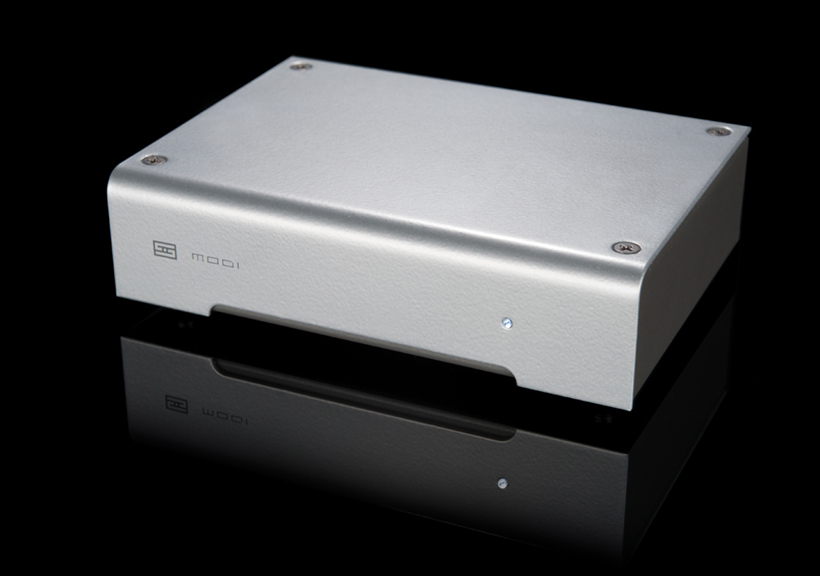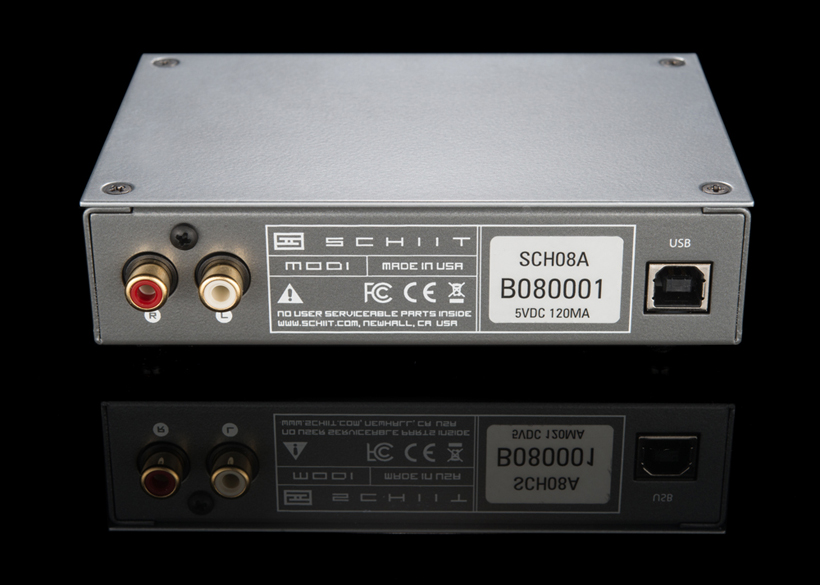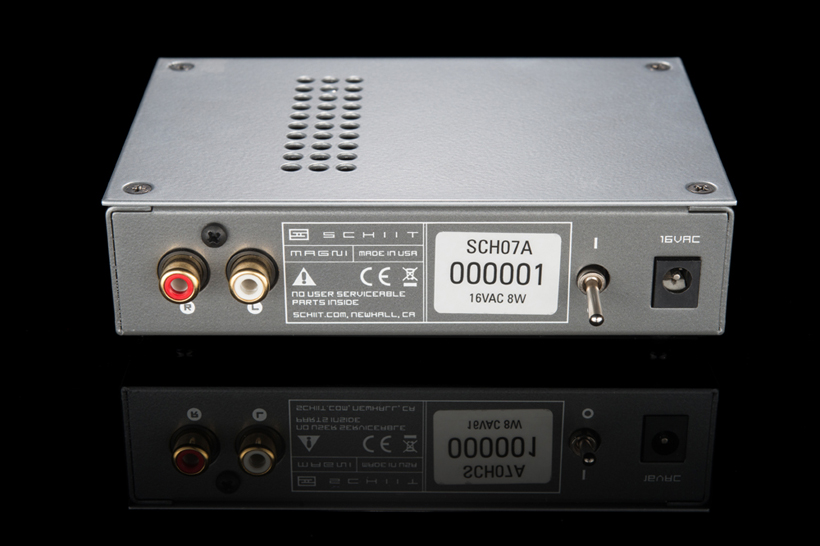The Modi and Magni are the newest models from the increasingly popular, North American based Schiit Audio. The naughtily named maker of DAC and headphone amplifier separates now have an official UK distributor in Electromod, who sold me this combo. Electromod started selling high end audio products like this in 2011 (Hifiman and Stax were first), but for the past decade they've been servicing audio equipment (like Mark Levinson) under the name High End Workshop.
This combo of DAC and headphone amplifier aims to deliver high quality audio to those on a very tight budget (comparatively of course). In the US they're priced at $99 a piece, but here in the UK they are not quite as cheap and there are a couple of good reasons for that. Apart from saving you from high postage costs, risk of damage, VAT, duty and handling charges, weeks stuck in customs etc. The main thing you get by buying from Electromod is an actual 230 volt power supply – the adapter supplied in the US does not support European voltages. Last but not least – If anything does go wrong you'll be able to fall back on service and expertise right here in the UK. Take it from me; if you were to send something back to the US for repairs, not only would it cost a lot and be risky to ship, but avoiding a second customs fee is troublesome. I seem to be droning on a bit here, so let me clarify that I'm not obliged to say any of this for Electromod's sake, I'm saying this purely for your benefit. If my experience of dealing with overseas hi-fi companies has taught me anything it's to appreciate the simplicity and security of buying direct from a UK seller. On face value it might seem cheaper to buy direct, but in reality it's a false economy. Electromod also offer the ability to try out the Schiit range in the comfort of your own home for £20. As much as I try to help people find what they want by writing reviews I can't stress enough how great this kind of service is!
Right, time for some techy stuff. The Modi is an asynchronous USB (only) DAC, with an AKM4396 chip. Its driverless connection is capable of converting a digital signal up to 24bit 96Khz (also supports the tricky 88.2Khz) and is powered by the 5v USB bus. The Modi is compatible with Windows or MAC, but Linux support is poor, so please be careful if you use a Linux based OS. The Magni is a dedicated Class AB headphone amplifier, powered by a 16v adapter, which drives a high power output of 1.2w at 32 Ohms. It's said to cope with demanding orthodynamic headphones like the Hifiman HE-6 (which I'm sorry to say I don't have here). These are two very well specified machines for the price, so let's see how they deal with a variety of headphones.

Sound
The sound of the Modi and Magni combination is very impressive considering their modest size and price! There's great body to the low frequencies and they have a generally balanced tonality that manages to squeeze the best out of many good headphones. I especially enjoyed the combo with larger, more open sounding headphones. I keep taking the Sennheiser HD650 to the Schiit combo rather than some considerably more expensive DAC/amp combos. The Schiits may not be able to match the detail of some more expensive units, but the tonality is just so musical and spacious I can't fault them for the price.
The 600 Ohm Beyerdynamic DT880 was driven by the Magni's power with ease. The 32 Ohm limited Edition DT770 sounded a little flat in it's imaging at first, but this was most likely due to me listening to a bunch of higher priced, open back classics. Fortunately after a few tracks they started to really loosen up and I found the Modi / Magni / DT770 combo highly enjoyable. They produced a huge and deep bass kick at the same time as delivering a lively midrange that didn't feel overly bright.
I've become increasingly underwhelmed bt the AKG Q701 recently due to a lack of bass body on many combined amps, but unusually I appreciated them even more than the Beyerdynamic DT880s through the Modi and Magni. The amplification of the Magni does great things with the AKG's bass as well as it's detail. They still sound rather harsh in the high frequencies, but even this was easier on the ears with the Magni compared to most of the more affordable solid state amps.
The AKG's greater than usual warmth made me wonder if the Magni is adding more than a healthy amount of bass body to the presentation in general, so I decided to test this by trying the Denon AH-D7000s with their speaker like sub-bass qualities. This would have shown if the Magni was bloating the bass frequencies at all, but it certainly didn't seem to be the case. The Denons sounded very neutral with the Magni and mostly it was their spacious and airy qualities that shone through. The bass was still very deep and potent, but not in an uncharacteristic way.
The Modi and Magni combination doesn't have to be used together of course, but I would say that they make pretty good partners. There's a nice upgrade path set out within the company’s own product range too. If you were to start with the Modi and Magni the most obvious next move seems to be upgrading the Magni to the Asgard (next model up). The very capable Modi should make a good partner to this machine too, if not in size at least in style and sound.
The massive amount of power on tap with the Magni and the way it's distributed through the volume dial is slightly better suited to less sensitive headphones. But it works fairly well with more sensitive, portable headphones like the Sennheiser Momentum or the Beyerdynamic DT770 Pro Limited Edition too.

Comparisons
I have been thinking about whether it's fair to compare the Modi and Magni to combined USB DACs at around £230. Remember when buying this combo you will need to also factor in some extra cash for a pair of RCA cables. The ones I've used here are the Epiphany Acoustics Atratus, which have recently been reduced to £40 and thus brings the price of the Schiit combo to £270. You could save yourself some money here by using budget cables or anything you have laying around. If you don't really know what to go for Electromod has you covered. They have cables specifically to go with the Schiit range, called 'PYST' (Put Your Schiit Together – I'm not even going to go there). These are priced at half the cost of the Epiphany (£20), so even more reasonable. I won't go into USB cables as I still haven't used any special 'audio' type ones for my setups yet. I am more sceptical about USB cables (because they're digital), but I like to keep an open mind, so you might see me trying some out soon. Anyway, where was I. Oh yeah, the competition.
Considering the Modi and Magni as a pair the most similarly priced device that I've reviewed is the Fostex HP-A3. There are many differences to note here though, firstly the HP-A3 is purely USB bus powered (DAC and amp). This makes it convenient for portable use, it's also smaller and lighter. Perhaps more importantly the HP-A3 can be connected to speakers more easily since its RCA outputs are not needed while listening to headphones. The HP-A3 can drive demanding headphones quite well considering it's running from a meagre five volts, so of course its amplifier cannot match the power output of the Magni. For more demanding orthodynamic headphones this will make all the difference. The HP-A3's amplification sounds quite different in it's tonality. It has less emphasis on the lower frequencies and more on it's midrange. I like what the Fostex does to some of my headphones, but there are quite a few that sound better through the Modi and Magni. The soundtage capabilities of both machines are fairly equally matched, but the details do feel a bit more clearly resolved with the HP-A3.
The Yulong D100 mkII is little bit more expensive, it has the connectivity benefits of the HP-A3 plus a load more, and better functionality. Both the Yulong and the Schiit combo are mains powered, although the D100 mkII's power supply is internal and this explains most of its extra size and weight. Both units have asynchronous USB inputs. Their tonalities and detail are also fairly equally matched too. Choosing a winner between the two here would come down to only a couple of simple things. If you don't want to switch between your headphones and speakers and you like a bit more bass body then go for the Modi and Magni. If you want more digital inputs, speakers are important to you and you have more desktop space then go for the D100 mkII.
On the slightly cheaper side of the Modi and Magni are models like the Arcam rPAC. Like the Fostex HP-A3 this is a more portable machine, which can be run directly from laptop power, it can also power speakers and headphones without having to switch out the the RCA cables. On the sound front things I prefer the Modi and Magni. The Schiit combo has deeper bass with more body, the midrange is also more refined and the analogue volume of the Magni is much nicer to control. If you can stretch your budget to accommodate the Modi and Magni and powering speakers from your computer is less important then this is where my recommendation would be.

Music
Here are my thoughts on how the Modi and Magni manage to drive a range of headphones with different types of music. Most were listened to in lossless format, but all of them are available on Spotify (tested at maximum quality). I used two different desktop PCs and a laptop (all using Windows 7) The software that I used for the lossless files used to be JRiver MC17, but I have gone off it lately because of the fiddly, over-complicated interface. I have gone back to using Foobar (v1.2.3) and use the latest WASAPI driver (v3.2.1), which now has two modes for better compatibility (event and push). I still can't believe that this software is free!
• Jimi Hendrix: All Along The Watchtower
• This classic guitar and vocal track is nicely represented on the AKG Q701s, although it sounds a little bit light in body the Magni pushes them far better than most similarly priced amps I've heard.
• Erik Mongrain: Air Tap!–
• The Sennheiser HD650 does a superb job at forming a realistic, detailed and speedy presentation of the guitar with the Modi and Magni combo. It has a very spacious and coherent sound with most genres, but guitar solos sound superb with this combination.
• Feed Me, Tasha Baxter: Cloudburn
• The deep electronic bass and vocals sound awesome; powerful, yet clear and balanced while driving the Mr Speaker Mad Dogs. There is a really nice feeling of space and separation here. These headphones really shine with a little push of the Magni's power.
• Clint Mansell (Moon): Welcome To Lunar Industries
• The star of this atmospheric and harrowing score (especially if you've seen the movie) is the tuneful piano piece. Despite there being a lot going on in the track it's easy to pick out and enjoy using the 32 Ohm Beyerdynamic DT770 Pros. These headphones are famed for their spiky upper midrange and I think this does wonders for the piano. The deep rumbling bass that they're capable of on the Magni is also great here.
• Rihanna: Shut Up And Drive
• This song was wonderfully dynamic and spacious through the Denon AH-D7000. The bass is very powerful and deep but midrange and vocals are utterly unaffected by any of this bass power – remaining as clean, bold and as clear as more neutral sounding headphones like the Sennheiser HD600. The highs sparkle really nicely, without emphasising sibilance.

Build
The casework on both the Modi and Magni is in thick sheets of nicely finished metal. It's simple, but the little design flourishes at the bottom feel like minimalist style rather than bare minimum. The machined holes on the top of the amp look great too and the two-tone coloured chassis is really strong and pretty. All in all it’s an unusual level of quality for the price. It seems like you're benefiting from the experience that Schiit have gained with much higher priced models.
The metal volume dial is nice and smooth to turn and there’s only a little channel imbalance low down. The only down side is it can be a bit fiddly with sensitive headphones to get the desired volume. I never quite understood why these dials are made with grooves going around the cylinder, but I'm sure that's personal taste more than anything else. I would rather have something that aids with grip rather than feels like a finely machined screw, but that's a small gripe in the scheme of things.
I would also feel I was nit-picking if I mentioned the plastic headphone socket. I am fine with a few corners being cut to give a better price/performance ratio if it doesn't hurt anyone. One area that I will bring up as an annoyance, however, are the piercing white LED lights that tell you the devices are on, they're extremely bright. In the case of the Magni it's not too bad because you can switch the player off, but with the Modi there is no way to get it to go off while it's connected to a system. My main set-up for the Schiit combo was a desktop computer in my bedroom, where the motherboard powers the USBs at all times. I ended physically unplugging the USB cable from the Modi every night because it was lighting up my room, after a week it wound me right up. I know, I'm complainy bitch, so make of that 'worst complaint' what you will.
Final thoughts
I've been smitten by the Modi and Magni combo ever since I hooked them up to my computers. I love the looks, the form factor and the build quality. The sound is beautifully dynamic, superbly detailed and extremely spacious. They manage to push the sound in the right direction with almost every pair of headphones that I throw at them. The power and performance they possess is highly impressive considering their modest price and I would not hesitate to recommend them to anyone who is looking for a dedicated headphone rig.
Equipment used
Desktop PC, Dell Vosto Laptop, Fostex HP-A3, Arcam rPAC, Audiolab M-DAC, Beyerdynamic DT880 600 Ohm, Beyerdynamic DT770 Pro Limited Edition 32 Ohm, Denon AH-D7000, Mad Dog (Fostex T50rp mod)
This review was originally published on Ed's noblehifi.blogspot.co.uk


